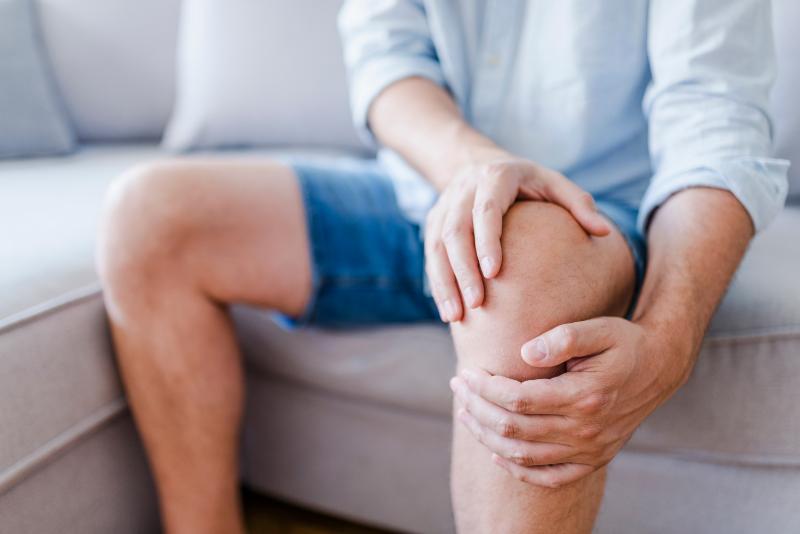Osteoarthritis (OA) is a degenerative joint condition that affects protective tissue around the bones (cartilage) in the joints. According to the CDC, osteoarthritis is a condition that impacts over 32.5 million adults in the United States alone.
OA can significantly impact your quality of life since the discomfort caused due to pain and stiffness can limit your daily activities. While osteoarthritis can damage any joint, it is most commonly seen in the hand, knees, and hip joints.
Osteoarthritis is the most commonly seen form of arthritis, and it is characterized by the progressive breakdown of joint tissues over time. Joints are the meeting point of bones and enable movement for the human body.
- Articular cartilage covers the ends of bones. They ensure smooth motion and act as a shock absorber.
- Synovial fluid lubricates the joint.
- Ligaments and tendons provide stability.
Osteoarthritis disrupts the functioning of these components by eroding the cartilage, leading to bone-on-bone contact, inflammation, and structural changes. As the condition progresses, the cartilage surface becomes irregular and wears out, exposing the underlying bone.
When the body attempts to repair this damage, it can lead to osteophytes or bone spurs, causing grating sensations during joint movement. Inflammation in the joints further contributes to pain and stiffness in this region.
This degenerative joint disease is usually seen in older people. Patients with osteoarthritis typically experience joint pain and may experience temporary stiffness following periods of rest or inactivity.
Osteoarthritis often begins subtly with mild joint discomfort, especially after rest or inactivity. Another early sign is a subtle decline in joint flexibility.
If you have osteoarthritis, you may find it challenging to move the joint through its full range of motion. This causes a sense of stiffness in the affected joint. When the condition worsens, you may also experience joint swelling and tenderness due to the increased friction and wear within the joint.
You may be at higher risk of developing osteoarthritis in the following conditions.
- Age - Osteoarthritis is often associated with the natural aging process. As joints endure years of use, the risk of wear and tear increases.
- Genetics- If there's a family history of osteoarthritis, you may be more at risk than others.
- Gender - Women are more commonly affected by osteoarthritis, especially after the age of 50.
- Obesity - Carrying excess weight can place extra stress on weight-bearing joints, such as the knees and hips. This increased load accelerates the deterioration of cartilage.
- Joint Injuries and Overuse - Joint injuries, whether from sports, accidents, or repetitive overuse, can increase your risk of osteoarthritis. Even seemingly minor injuries can lead to joint degeneration over time.
Diagnosis often begins with a thorough understanding of the patient's symptoms. Detailed information about the nature, duration, and triggers of joint pain, stiffness, and other discomforts is crucial.
A comprehensive medical history includes inquiries about previous joint injuries or conditions because these can contribute to the development of osteoarthritis.
Your doctor will conduct a hands-on examination to assess the affected joint's movement and flexibility. Restricted motion and signs of discomfort during this examination provide valuable diagnostic clues.
Additionally, any swelling or deformities around the joint area indicate the extent of joint damage and help determine the severity of your condition.
Other diagnostic tests may include X-rays, MRIs, and CT scans can help:
- Visualize joint structures
- Identify joint space narrowing
- Bone spurs
- Overall condition of the affected joint
Depending on the severity of your condition, treatment options can include both nonsurgical and surgical solutions.
Nonsurgical approaches may include:
- Implementing lifestyle changes, such as weight management and moving to joint-friendly activities, can alleviate symptoms and slow down the condition's progression.
- Employing targeted exercises and physical therapy can enhance joint function, strengthen surrounding muscles, and improve overall mobility.
- Using pain management techniques, including medications and topical treatments, can alleviate discomfort.
Surgical interventions may be recommended if conservative treatments prove ineffective for your case. This can involve:
- Cortisone Injections - This involves administering corticosteroids into the affected joint can offer temporary pain relief. The frequency of cortisone injections is generally limited to three or four shots per year.
- Lubrication Injections - Hyaluronic acid injections aim to alleviate pain by providing cushioning within the joint.
- Joint Replacement Surgery - In cases of severe joint damage, joint replacement surgery may be needed. This procedure involves the removal of damaged joint surfaces, replacing them with synthetic components made of plastic and metal.
Total Joint Replacement (TJR) is a transformative surgical procedure designed to relieve pain, revive function and movement, and enhance the overall quality of life for patients with severely damaged joints.
TJR can provide effective pain relief, enabling patients to engage in daily activities more comfortably. The procedure helps enhance joint function, promoting better mobility and flexibility.
TJR can significantly improve patients' overall quality of life by helping restore independent movement and reducing the impact of joint pain on daily activities.
This procedure is commonly performed on weight-bearing joints such as the hip, knee, and shoulder. The procedure aims to relieve pain, enhance joint function, and improve overall mobility.
At Kimball Health Services, TJR procedures are performed utilizing MicroPort Orthopedic products.
Hip Replacement
Hip replacements are often recommended for individuals with osteoarthritis, rheumatoid arthritis, or hip fractures.
During a hip replacement procedure, the damaged hip joint is replaced with a metal, ceramic, or plastic implant. This can significantly reduce pain and improve hip function, making daily activities more manageable.
Knee Replacement
Knee replacements are commonly performed for patients with advanced osteoarthritis, rheumatoid arthritis, or significant knee injuries.
A knee replacement surgery involves resurfacing damaged parts of the knee joint with artificial components.
Shoulder Replacement
Shoulder replacements are often recommended for those with severe arthritis, rotator cuff injuries, or fractures affecting the shoulder joint.
During shoulder replacement surgery, damaged parts of the shoulder joint are replaced with artificial components.
At Kimball Health Services, we employ a comprehensive approach to diagnosing and treating osteoarthritis. Our board-certified orthopedic surgeon, Dr. Jeffrey T. MacMillan, and Karen Wenner, APRN, DNP, offer both nonsurgical and surgical treatment options for your orthopedic concerns.
As one of the top critical access hospitals in the nation, we pride ourselves on delivering high-quality, patient-centered care.
In case of an emergency, call 911 or walk into our emergency department anytime. For appointments, call ahead or fill out our online form. We're here for you whenever you need us.








